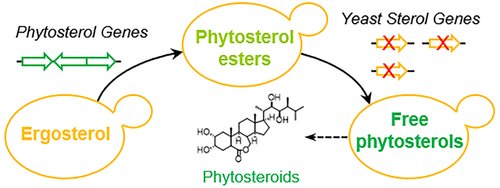当前位置:
X-MOL 学术
›
ACS Synth. Biol.
›
论文详情
Our official English website, www.x-mol.net, welcomes your
feedback! (Note: you will need to create a separate account there.)
Engineering of Phytosterol-Producing Yeast Platforms for Functional Reconstitution of Downstream Biosynthetic Pathways
ACS Synthetic Biology ( IF 3.7 ) Pub Date : 2020-10-21 , DOI: 10.1021/acssynbio.0c00417 Shanhui Xu 1 , Curtis Chen 1, 2 , Yanran Li 1
ACS Synthetic Biology ( IF 3.7 ) Pub Date : 2020-10-21 , DOI: 10.1021/acssynbio.0c00417 Shanhui Xu 1 , Curtis Chen 1, 2 , Yanran Li 1
Affiliation

|
As essential structural molecules for plant plasma membranes, phytosterols are key intermediates for the synthesis of many downstream specialized metabolites of pharmaceutical or agricultural significance, such as brassinosteroids and withanolides. Saccharomyces cerevisiae has been widely used as an alternative producer for plant secondary metabolites. Establishment of heterologous sterol pathways in yeast, however, has been challenging due to either low efficiency or structural diversity, likely a result of crosstalk between the heterologous phytosterol and the endogenous ergosterol biosynthesis. For example, in this study, we engineered campesterol production in yeast using plant enzymes; although we were able to enhance the titer of campesterol to ∼40 mg/L by upregulating the mevalonate pathway, no conversion to downstream products was detected upon the introduction of downstream plant enzymes. Further investigations uncovered two interesting observations about sterol engineering in yeast. First, many heterologous sterols tend to be efficiently and intensively esterified in yeast, which drastically impedes the function of downstream enzymes. Second, yeast can overcome the growth deficiency caused by altered sterol metabolism through repeated culture. By employing metabolic engineering, strain evolution, fermentation engineering, and pathway reconstitution, we were able to reconstruct the multienzyme pathways for the synthesis of a set of phytosterols: campesterol (∼7 mg/L), β-sitosterol (∼2 mg/L), 22-hydroxycampesterol (∼1 mg/L), and 22-hydroxycampest-4-en-3-one (∼4 mg/L). This work identified and addressed some of the technical bottlenecks in phytosterol-derived pathway reconstitution in the baker’s yeast and opens up opportunities for efficient bioproduction and metabolic pathway elucidation of this group of phytochemicals.
中文翻译:

用于下游生物合成途径功能重建的植物甾醇生产酵母平台的工程化
作为植物质膜的基本结构分子,植物甾醇是合成许多具有药学或农业意义的下游特殊代谢物的关键中间体,例如油菜素类固醇和内酯。酿酒酵母已被广泛用作植物次生代谢物的替代生产者。然而,由于低效率或结构多样性,在酵母中建立异源甾醇途径一直具有挑战性,这可能是异源植物甾醇和内源性麦角甾醇生物合成之间串扰的结果。例如,在这项研究中,我们使用植物酶在酵母中设计了菜油甾醇的生产;尽管我们能够通过上调甲羟戊酸途径将菜油甾醇的效价提高到~40 mg/L,但在引入下游植物酶后没有检测到下游产品的转化。进一步的调查发现了关于酵母中甾醇工程的两个有趣的观察结果。首先,许多异源甾醇往往在酵母中被有效而强烈地酯化,这极大地阻碍了下游酶的功能。其次,酵母可以通过重复培养克服由甾醇代谢改变引起的生长缺陷。通过采用代谢工程、菌株进化、发酵工程和途径重建,我们能够重建合成一组植物甾醇的多酶途径:菜油甾醇(~7 mg/L)、β-谷甾醇(~2 mg/L )、22-羟基菜油甾醇 (~1 mg/L) 和 22-hydroxycampest-4-en-3-one (~4 mg/L)。这项工作确定并解决了面包酵母中植物甾醇衍生途径重建的一些技术瓶颈,并为这组植物化学物质的有效生物生产和代谢途径阐明开辟了机会。酵母菌可以通过重复培养克服甾醇代谢改变引起的生长缺陷。通过采用代谢工程、菌株进化、发酵工程和途径重建,我们能够重建合成一组植物甾醇的多酶途径:菜油甾醇(~7 mg/L)、β-谷甾醇(~2 mg/L )、22-羟基菜油甾醇 (~1 mg/L) 和 22-hydroxycampest-4-en-3-one (~4 mg/L)。这项工作确定并解决了面包酵母中植物甾醇衍生途径重建的一些技术瓶颈,并为这组植物化学物质的有效生物生产和代谢途径阐明开辟了机会。酵母菌可以通过重复培养克服甾醇代谢改变引起的生长缺陷。通过采用代谢工程、菌株进化、发酵工程和途径重建,我们能够重建合成一组植物甾醇的多酶途径:菜油甾醇(~7 mg/L)、β-谷甾醇(~2 mg/L )、22-羟基菜油甾醇 (~1 mg/L) 和 22-hydroxycampest-4-en-3-one (~4 mg/L)。这项工作确定并解决了面包酵母中植物甾醇衍生途径重建的一些技术瓶颈,并为这组植物化学物质的有效生物生产和代谢途径阐明开辟了机会。我们能够重建合成一组植物甾醇的多酶途径:菜油甾醇(~7 mg/L)、β-谷甾醇(~2 mg/L)、22-羟基菜油甾醇(~1 mg/L)和 22 -hydroxycampest-4-en-3-one (∼4 mg/L)。这项工作确定并解决了面包酵母中植物甾醇衍生途径重建的一些技术瓶颈,并为这组植物化学物质的有效生物生产和代谢途径阐明开辟了机会。我们能够重建合成一组植物甾醇的多酶途径:菜油甾醇(~7 mg/L)、β-谷甾醇(~2 mg/L)、22-羟基菜油甾醇(~1 mg/L)和 22 -hydroxycampest-4-en-3-one (∼4 mg/L)。这项工作确定并解决了面包酵母中植物甾醇衍生途径重建的一些技术瓶颈,并为这组植物化学物质的有效生物生产和代谢途径阐明开辟了机会。
更新日期:2020-11-21
中文翻译:

用于下游生物合成途径功能重建的植物甾醇生产酵母平台的工程化
作为植物质膜的基本结构分子,植物甾醇是合成许多具有药学或农业意义的下游特殊代谢物的关键中间体,例如油菜素类固醇和内酯。酿酒酵母已被广泛用作植物次生代谢物的替代生产者。然而,由于低效率或结构多样性,在酵母中建立异源甾醇途径一直具有挑战性,这可能是异源植物甾醇和内源性麦角甾醇生物合成之间串扰的结果。例如,在这项研究中,我们使用植物酶在酵母中设计了菜油甾醇的生产;尽管我们能够通过上调甲羟戊酸途径将菜油甾醇的效价提高到~40 mg/L,但在引入下游植物酶后没有检测到下游产品的转化。进一步的调查发现了关于酵母中甾醇工程的两个有趣的观察结果。首先,许多异源甾醇往往在酵母中被有效而强烈地酯化,这极大地阻碍了下游酶的功能。其次,酵母可以通过重复培养克服由甾醇代谢改变引起的生长缺陷。通过采用代谢工程、菌株进化、发酵工程和途径重建,我们能够重建合成一组植物甾醇的多酶途径:菜油甾醇(~7 mg/L)、β-谷甾醇(~2 mg/L )、22-羟基菜油甾醇 (~1 mg/L) 和 22-hydroxycampest-4-en-3-one (~4 mg/L)。这项工作确定并解决了面包酵母中植物甾醇衍生途径重建的一些技术瓶颈,并为这组植物化学物质的有效生物生产和代谢途径阐明开辟了机会。酵母菌可以通过重复培养克服甾醇代谢改变引起的生长缺陷。通过采用代谢工程、菌株进化、发酵工程和途径重建,我们能够重建合成一组植物甾醇的多酶途径:菜油甾醇(~7 mg/L)、β-谷甾醇(~2 mg/L )、22-羟基菜油甾醇 (~1 mg/L) 和 22-hydroxycampest-4-en-3-one (~4 mg/L)。这项工作确定并解决了面包酵母中植物甾醇衍生途径重建的一些技术瓶颈,并为这组植物化学物质的有效生物生产和代谢途径阐明开辟了机会。酵母菌可以通过重复培养克服甾醇代谢改变引起的生长缺陷。通过采用代谢工程、菌株进化、发酵工程和途径重建,我们能够重建合成一组植物甾醇的多酶途径:菜油甾醇(~7 mg/L)、β-谷甾醇(~2 mg/L )、22-羟基菜油甾醇 (~1 mg/L) 和 22-hydroxycampest-4-en-3-one (~4 mg/L)。这项工作确定并解决了面包酵母中植物甾醇衍生途径重建的一些技术瓶颈,并为这组植物化学物质的有效生物生产和代谢途径阐明开辟了机会。我们能够重建合成一组植物甾醇的多酶途径:菜油甾醇(~7 mg/L)、β-谷甾醇(~2 mg/L)、22-羟基菜油甾醇(~1 mg/L)和 22 -hydroxycampest-4-en-3-one (∼4 mg/L)。这项工作确定并解决了面包酵母中植物甾醇衍生途径重建的一些技术瓶颈,并为这组植物化学物质的有效生物生产和代谢途径阐明开辟了机会。我们能够重建合成一组植物甾醇的多酶途径:菜油甾醇(~7 mg/L)、β-谷甾醇(~2 mg/L)、22-羟基菜油甾醇(~1 mg/L)和 22 -hydroxycampest-4-en-3-one (∼4 mg/L)。这项工作确定并解决了面包酵母中植物甾醇衍生途径重建的一些技术瓶颈,并为这组植物化学物质的有效生物生产和代谢途径阐明开辟了机会。











































 京公网安备 11010802027423号
京公网安备 11010802027423号